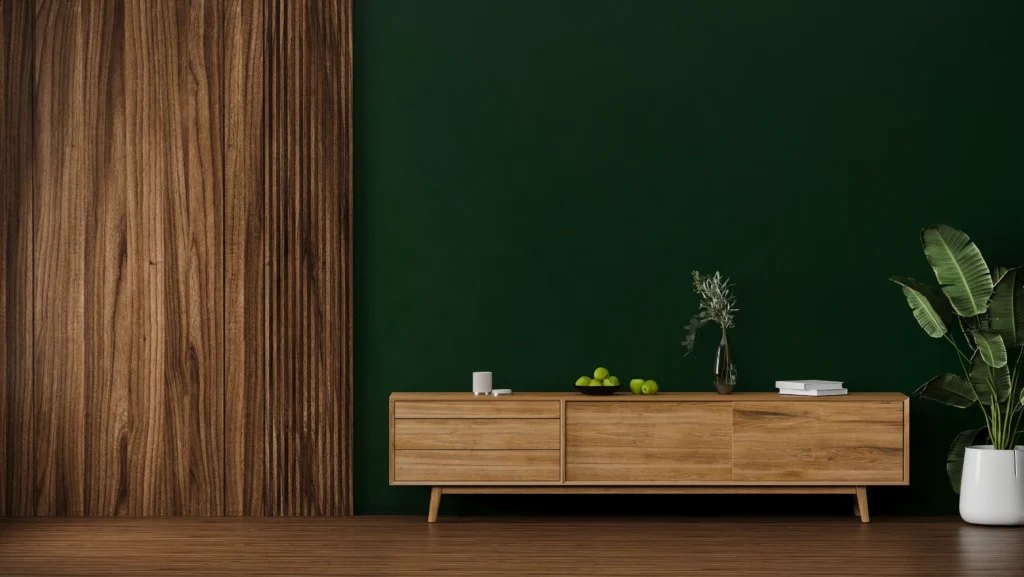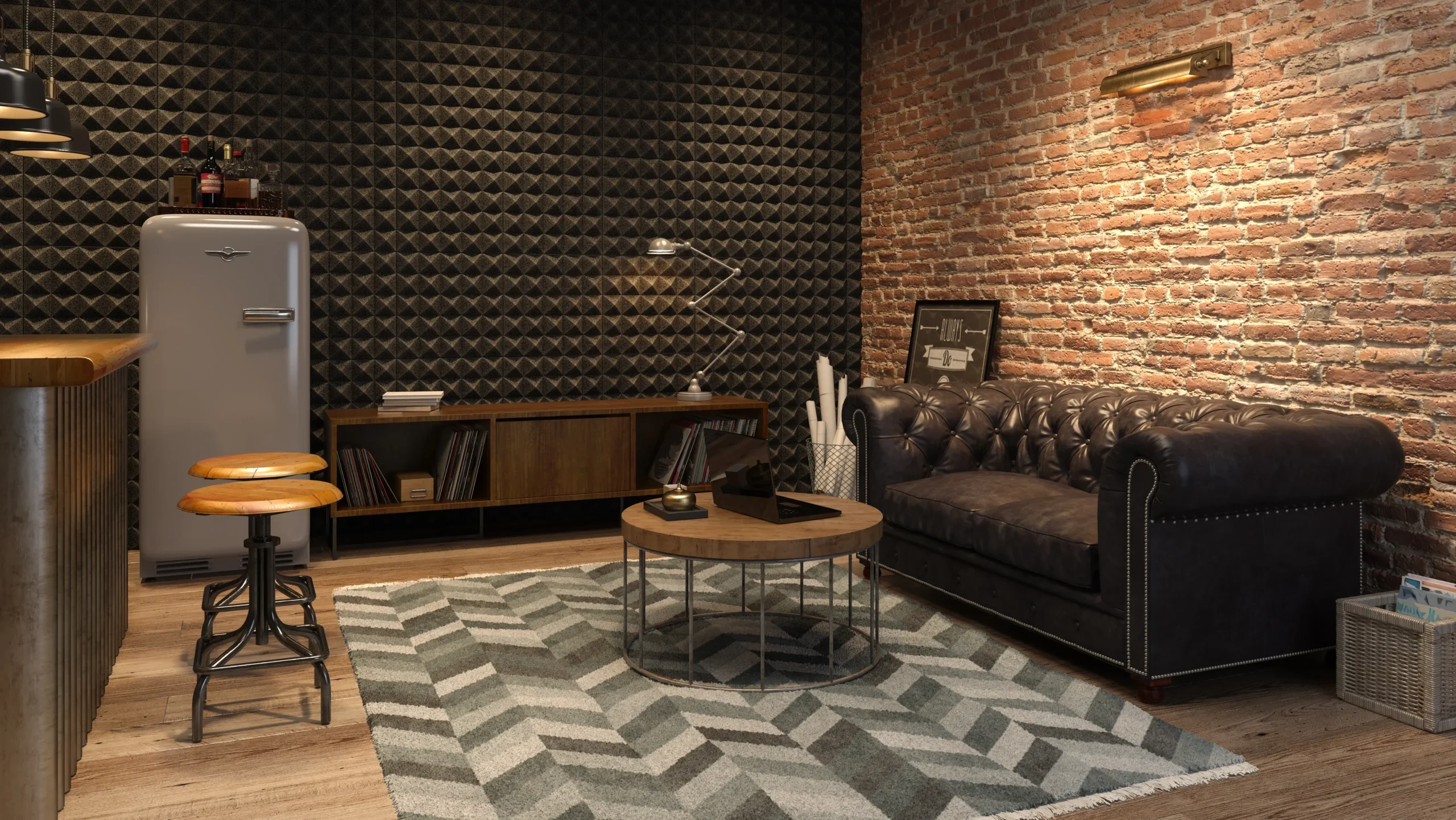Basements often get overlooked when it comes to home renovations. They are often left as storage areas or neglected corners of our homes, but they have the potential to become valuable living spaces or entertainment areas. One key element in transforming a basement into a functional and appealing part of your home is the use of basement wall panels. These panels offer both aesthetic and functional benefits, making them an attractive choice for homeowners looking to upgrade their basement walls.
Let’s talk about affordable basement wall panels, why they matter, and how to choose the right ones for your project.
9 Affordable Basement Wall Panels
When it comes to redesigning your basement, the choice of wall panels is crucial. Your basement wall panels should align with your style while also offering moisture resistance. Let’s dive into these cost-effective options that will elevate your basement’s appeal.
Wood Wall Paneling

Wood paneling brings warmth and texture to your basement, making it more inviting. With a variety of wood types and shades available, it’s easy to find an option that complements your budget and your room’s style. Shiplap, known for its affordability and popularity, is a straightforward choice. Beadboard or drop siding, available in linear and horizontal designs, can make your basement appear more spacious.
If your basement has uneven surfaces like popcorn ceilings or concrete floors, wood paneling can provide excellent coverage.
Decorative Panels
If you’re aiming for a stylish basement, decorative wall panels are an excellent choice. You have the freedom to customize these panels to your liking. Opt for materials like laminate, PVC sheets, prefabricated boards, or gypsum boards, all of which are waterproof and ideal for basements.
Rigid Foam Sheets
Rigid foam sheets are a cost-efficient and popular choice. Made of expanded polystyrene foam, they act as a barrier against water leaks and moisture. These sheets can help regulate your basement’s temperature and energy consumption. Ensure a tight installation to maximize their efficiency and prevent air and moisture infiltration.
Note that rigid foam sheets may not be suitable for walk-out basements or areas exposed to direct sunlight.
The average cost of basement wall panels is $15 to $25 per square foot.
-Home Advisor
Drywall
Drywall panels are a common and affordable choice for finishing basements. You should consider it if you love to DIY as it’s relatively easy to install. These panels are naturally fire-resistant, providing an added layer of safety. However, to ensure optimal moisture resistance, it’s crucial to source the right drywall tape, which can help prevent issues like mold and moisture infiltration. While drywall is not entirely waterproof, it offers a practical and economical solution for many basements.
Stone or Brick 3D Wall Paneling

Adding stone or brick paneling can significantly enhance your basement’s aesthetics without breaking the bank. These panels can be used in various ways, from creating a cozy cabin-like feel by placing them halfway up the wall to crafting a stunning feature wall or using them around a fireplace. Stone is often more budget-friendly than brick, making it a versatile choice.
Most of these panels are easy to install using adhesive. All you need to do is measure, cut, and carefully apply the panels to achieve a spectacular result.
Plastic Wall Panels
Ideal for humid or moist climates, plastic wall panels include drainage systems that prevent water leakage and protect against worsening cracks. They are a cost-effective solution for creating basement walls.
Using wall panels is a budget-friendly way to transform your basement. However, keep in mind that unfinished basement walls are porous and can absorb moisture. To prevent moisture-related issues, ensure proper ventilation and consider local regulations regarding vapor barriers.
Medium Density Fiberboard (MDF)
MDF is an excellent choice for basement walls. It consists of compressed wood waste, making it eco-friendly, affordable, and durable. MDF can soak up water and swell if it’s not protected. To shield it from moisture, it’s a good idea to apply a moisture-resistant coating like melamine before installing MDF panels. This will help ensure your basement walls stay in great shape for the long run.
Wahoo Walls
Wahoo Walls is a good option. These panels are super easy to install. No need for a bunch of studs or drywall. They don’t let mold grow, and they come with insulation. You don’t need a ton of carpentry skills to get Wahoo Walls up and running. They’re great for keeping your basement cozy and mold-free. Plus, they’re already insulated, so you’re good to go.
Flat Panels

Flat panels offer a modern and minimalist design, making them perfect for contemporary basement makeovers. They offer a sleek and modern look, perfect for those who prefer a minimalist design.
The simplicity of flat panels can be quite appealing, creating a clean and uncluttered look in your basement. If you’re aiming for a modern, minimalist design that complements your personal style, flat panels could be the ideal choice for your basement renovation project. They’re not only easy on the eyes but also gentle on your budget, proving that you don’t need to spend a fortune to achieve a stylish basement makeover.
With Wahoo Walls, you can transform your basement without breaking a sweat. Installing them is a breeze, and they’re mold-resistant and come with insulation. So, say goodbye to a chilly, damp basement!
FAQs
How can I cover my basement walls cheaply?
To cover your basement walls on a budget, consider options like affordable wall panels, such as drywall, wood paneling, or PVC panels. You can also explore DIY paint or wallpaper solutions for a cost-effective makeover.
What can I put on my basement walls instead of drywall?
Instead of drywall, you can use various materials such as wood paneling, basement wall panels, insulated foam panels, or decorative 3D wall panels to cover your basement walls. Each material offers different benefits and aesthetics to suit your preferences.
What is the best material to use for basement walls?
The best material for basement walls depends on your specific needs. Insulated foam panels, for example, are excellent for energy efficiency, while decorative panels offer unique design options. Assess your requirements, such as insulation and moisture resistance, to determine the best fit for your project.
Do I need a vapor barrier on my basement walls?
The necessity of a vapor barrier on basement walls depends on your local climate and moisture levels. In humid or wet regions, a vapor barrier can help prevent moisture infiltration and is often recommended. Check local regulations and consult with experts to make an informed decision.
How can I make my old basement walls look better?
You can improve the appearance of old basement walls by using various methods. Options include applying paint or wallpaper, installing decorative panels, or using wood paneling to cover imperfections. Proper lighting and creative decor can also enhance the overall look of your basement.
Summary
The choice of affordable basement wall panels largely depends on your design preferences and your basement’s unique needs. While wood and drywall panels are budget-friendly options, each panel type offers distinct advantages, and your final selection should align with your vision for your newly renovated basement. Don’t let a limited budget deter you from creating a beautiful and functional living space in your basement.
